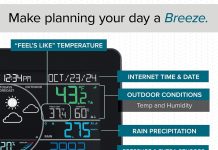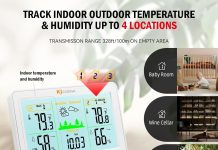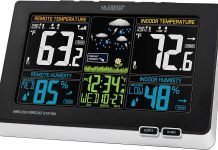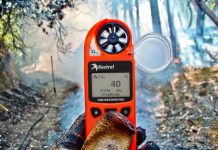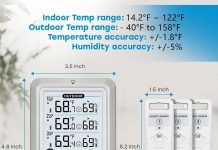What Home Weather Station Features Are Must-haves Vs. Nice-to-haves? In our article, we explore the key factors to consider when choosing a home weather station. From accurate temperature readings to wireless connectivity, we’ll help you navigate through the vast array of features available. By distinguishing between must-haves and nice-to-haves, we aim to simplify the decision-making process, ensuring that you make an informed choice that suits your specific needs. Whether you’re a weather enthusiast or simply looking to keep tabs on the local forecast, join us as we uncover the essential features that will enhance your weather monitoring experience.
Review contents
Sensors
Temperature
A home weather station should be equipped with a temperature sensor to accurately measure the ambient temperature in our surroundings. This is important for providing comprehensive weather information and ensuring that the collected data is accurate and reliable.
Humidity
In addition to monitoring temperature, a humidity sensor is another key feature that we consider a must-have in a home weather station. Humidity levels can greatly impact our comfort and overall health, and having this data readily available allows us to make informed decisions regarding indoor climate control and potential mold prevention.
Barometric Pressure
The inclusion of a barometric pressure sensor in a home weather station is highly beneficial for tracking changes in atmospheric pressure over time. This information can help us predict weather patterns, such as approaching storms or shifts in weather systems, and provide valuable insights into local climate conditions.
Wind Speed and Direction
Knowing the wind speed and direction is crucial for understanding current weather conditions and potential changes in the near future. By having a wind speed and direction sensor, we can accurately measure these parameters and gain valuable insights into weather patterns, wind-related hazards, and even opportunities for alternative energy sources such as wind power.
Rainfall
To complete a comprehensive picture of the local weather, a home weather station should include a rainfall sensor. This sensor allows us to measure and track the amount of precipitation in our area, helping us prepare for heavy rainfall, monitor drought conditions, and even optimize outdoor watering schedules.
Connectivity
Wireless
Wireless connectivity is an essential feature for a modern home weather station. By leveraging wireless technology, we can easily connect our weather station to various devices, such as smartphones, tablets, or computers, without the need for cumbersome cables. This allows us to remotely access real-time weather data and control our weather station with convenience and ease.
Internet Connectivity
Having internet connectivity in a home weather station opens up a world of possibilities. By connecting our weather station to the internet, we can access weather data from anywhere, share our data with other weather enthusiasts, and even contribute to larger weather networks and forecasting models. This feature empowers us to be part of a wider weather community and stay informed about local and global weather conditions.
Smart Home Integration
With the growing popularity of smart home technology, the integration of a home weather station with smart home systems is becoming increasingly important. By integrating our weather station with our smart home devices, we can automate various actions based on weather conditions. For example, we can have our smart thermostat adjust the indoor temperature based on outdoor conditions or receive notifications on our smart speaker when severe weather is predicted.
Data Accuracy
Calibration
To ensure accurate weather data, a home weather station should offer a calibration feature. Calibration allows us to fine-tune the sensors and adjust their readings to match local conditions. With proper calibration, we can trust that our weather station provides accurate and reliable data, making it a valuable tool for monitoring and understanding the weather in our specific location.
Data Precision
In addition to accuracy, data precision is another important aspect of a quality home weather station. Precision refers to the level of detail and granularity in the measurements provided by the sensors. A weather station with high data precision can detect even subtle changes in temperature, humidity, or wind speed, providing us with a more comprehensive view of current weather conditions and trends.
Data Update Frequency
The frequency at which a home weather station updates its data is also a crucial factor to consider. A station that provides frequent updates ensures that we have access to the most up-to-date weather information. This is particularly important during rapidly changing weather conditions or when we need real-time updates for outdoor activities or planning purposes.
Display
Screen Size
A clear and easy-to-read display is essential for quickly and effortlessly accessing weather information. When considering a home weather station, we should look for a display with an adequate screen size that allows us to view the data at a glance, without squinting or straining our eyes.
Backlight
A backlight feature is particularly important for readability in low-light or nighttime conditions. It ensures that we can easily read the display regardless of the ambient lighting. A backlight also enhances the overall user experience, providing convenience and ensuring that we can access weather information whenever we need it.
Easy-to-Read Interface
A user-friendly interface is key to maximizing the usefulness of a home weather station. The display should present the weather data in a clear and organized manner, making it easy for us to navigate and understand the information being presented. A well-designed interface enhances our overall interaction with the weather station and makes it a pleasure to use on a daily basis.
Data Storage and Retrieval
Internal Memory
Having an internal memory feature in a home weather station allows us to store a certain amount of historical weather data directly on the device. This is beneficial for analyzing past weather patterns, comparing current conditions to historical data, and identifying long-term trends. Internal memory also ensures that we don’t lose valuable data, even if internet connectivity is temporarily unavailable.
Cloud Storage
Cloud storage is an increasingly popular option for storing and accessing weather data. By leveraging cloud technology, a home weather station can seamlessly and automatically store data in a secure online environment. This provides the added benefit of convenient access to our weather data from any device connected to the internet. Cloud storage also serves as a backup, protecting our data in case of a physical malfunction or damage to the weather station.
Data Export Options
The ability to export weather data is another valuable feature to consider. Exporting data allows us to analyze it with other software or share it with fellow weather enthusiasts or scientists who can use the data for research or forecasting purposes. Whether through email, file transfer protocols, or integrations with popular data analysis platforms, having various data export options greatly enhances the versatility and usefulness of a home weather station.
Power Source
Battery-Powered
Battery-powered home weather stations offer flexibility and portability. They can be easily set up in various locations without the need for a nearby power outlet and are perfect for those who frequently move their weather station or want to monitor weather conditions in remote areas. However, it is essential to consider the battery life and ensure that the station’s power source can sustain long periods without requiring frequent battery replacements.
Solar-Powered
For those seeking an eco-friendly and cost-effective option, a solar-powered home weather station is an excellent choice. Solar panels harness the power of the sun to charge the station’s internal battery, eliminating the need for external power sources or regular battery replacements. This sustainable power solution ensures that our weather station operates reliably while reducing our carbon footprint.
AC Adapter
AC adapters provide a reliable and continuous power supply for home weather stations. They eliminate concerns about battery life or the availability of sunlight, ensuring that the station always remains operational. AC adapters are particularly suitable for stationary installations where a power outlet is readily accessible. However, it is important to consider the location of the weather station relative to the power source and ensure that appropriate measures are taken to safeguard against power outages or surges.
Alerts and Notifications
Severe Weather Warnings
Receiving timely notifications about severe weather events is crucial for our safety and preparedness. A home weather station that provides severe weather warnings is a must-have feature. These warnings can alert us to rapidly changing weather conditions, such as thunderstorms, hurricanes, or tornadoes, allowing us to take necessary precautions and ensure the well-being of ourselves and our loved ones.
Customizable Alerts
Every individual has unique weather concerns and preferences. A home weather station with customizable alerts allows us to set specific parameters or thresholds for weather conditions that are of particular interest to us. Whether it’s high winds, low temperatures, or specific precipitation levels, being able to customize alerts ensures that we are notified about the weather situations that matter most to us.
Mobile Notifications
In our fast-paced and mobile-centric world, having the ability to receive weather notifications on our smartphones or tablets is highly beneficial. Mobile notifications keep us informed about weather changes even when we are away from our home weather station. Whether we are at work, on the go, or simply in another room, we can stay connected to the current weather conditions and any alerts or warnings that may arise.
Forecasting
Real-Time Weather Updates
Real-time weather updates are a valuable feature for keeping us informed about the latest weather conditions. A home weather station that provides real-time updates ensures that we are continuously aware of any sudden changes or developments. This information is particularly helpful for planning outdoor activities or adjusting our schedules based on current weather conditions.
Short-Term Weather Predictions
Being able to access short-term weather predictions is important for day-to-day planning. A home weather station that offers short-term forecasts allows us to anticipate weather changes over the next few hours or days, helping us make informed decisions about outdoor activities, clothing choices, or necessary preparations. This feature helps us stay one step ahead of the weather and adapt our plans accordingly.
Long-Term Weather Forecasts
For those who want a broader view of the upcoming weather conditions, a home weather station with long-term weather forecasts is a nice-to-have feature. Long-term forecasts provide insights into weather patterns, trends, and potential changes over a longer period. While these forecasts may not always be as precise as short-term predictions, they can still be valuable for planning vacations, outdoor events, or long-term projects.
Additional Features
UV Index Measurement
Monitoring the UV index is important for protecting our skin from harmful sun exposure. A home weather station that includes a UV index measurement feature provides us with the necessary information to take appropriate sun protection measures. By knowing the intensity of the UV radiation, we can adjust our outdoor activities, apply sunscreen, or seek shade to minimize the risk of sunburn or long-term skin damage.
Indoor Weather Monitoring
While outdoor weather conditions are essential, indoor weather monitoring is becoming increasingly popular. A home weather station equipped with indoor sensors allows us to monitor temperature, humidity, and potentially air quality within our home. This feature helps us optimize our indoor climate control, ensure comfortable living conditions, and identify any potential issues or inefficiencies within our living spaces.
Air Quality Index
Given the increasing concern about air pollution and its impact on our health, having an air quality index measurement feature in a home weather station is advantageous. This feature provides insights into the quality of the air in our immediate surroundings, allowing us to take appropriate measures such as using air purifiers, adjusting ventilation, or avoiding outdoor activities during periods of poor air quality. Monitoring the air quality index helps us make informed decisions regarding our well-being and ensures that we are aware of potential risks to our respiratory health.
Price Considerations
Budget-Friendly Options
For those on a tight budget, there are affordable home weather station options available that still offer essential features. While they may not have all the bells and whistles of higher-end models, budget-friendly weather stations can still provide accurate temperature, humidity, and basic weather information. These options are suitable for those who prioritize essential functionality and are not looking for advanced features or extensive data analysis.
Higher-End Models
Higher-end home weather stations often come with a wider range of sensors, advanced features, and enhanced data analysis capabilities. These models may offer more precise measurements, broader connectivity options, and additional forecasting capabilities. For those who are weather enthusiasts, professional meteorologists, or simply seeking a more comprehensive weather monitoring experience, investing in a higher-end model may be well worth it.
Value for Money
When considering the price of a home weather station, it is important to assess the overall value for money. Rather than focusing solely on the price tag, we should evaluate the features, functionality, and durability of the weather station. A higher-priced model with extensive features may offer more long-term value if it meets our specific weather monitoring needs and provides accurate and reliable data. Ultimately, finding the right balance between price and functionality ensures that we get the most out of our investment in a home weather station.
In conclusion, a home weather station offers valuable insights into local weather conditions, providing us with the ability to make informed decisions and stay connected to our environment. While each person’s preferences may vary, certain features stand out as must-haves when choosing a home weather station. These features include temperature, humidity, barometric pressure, wind speed and direction, and rainfall sensors, as well as wireless connectivity, internet connectivity, and smart home integration. Data accuracy, precision, and update frequency are crucial for reliable weather information, while a user-friendly display enhances the overall user experience. Storage options, power source, alerts and notifications, and forecasting capabilities add further functionality to the weather station. Additional features such as UV index measurement, indoor weather monitoring, and air quality index assessment provide valuable insights beyond traditional weather data. Considering both budget-friendly options and higher-end models helps strike the right balance between cost and functionality, ensuring value for money. By carefully assessing the features and capabilities of a home weather station, we can choose one that meets our specific needs and enhances our understanding and enjoyment of the weather around us.




